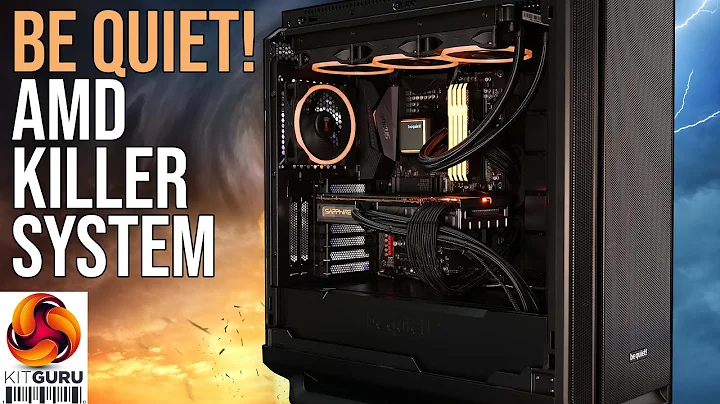Unboxing the World's Fastest CPU: AMD Threadripper 5000!
Table of Contents
- Introduction
- The AMD Threadripper 5000 System
- testing Blade Bit and Geoplotting
- System Configuration and Benchmarking
- Memory Bandwidth and Performance
- Passmark CPU and Memory Benchmark Results
- Sorting Algorithm Comparison
- Plotting Performance Comparison: Ice Lake vs Threadripper
- Practical Plotting Considerations
- Future Testing and Conclusion
Introduction
Hey guys, it's JM! I recently had the opportunity to test the AMD Threadripper 5000 system for Chia benchmarking. An old colleague at Intel who works at the Workstation Group in AMD sent over the system, and I've been exploring its capabilities over the past few days. In this article, we'll dive into some interesting insights and hypotheses about what makes the fastest Chia plotter, particularly in terms of blade bit performance. We'll explore system settings, conduct benchmark tests, and compare the AMD Threadripper with the Ice Lake processor. Get ready for some exciting findings!
The AMD Threadripper 5000 System
The AMD Threadripper 5000 system I received is an absolute beast of a CPU. In fact, it is currently the fastest single CPU in the world, according to Passmark ratings. The system, a Lenovo 620 workstation, provides the perfect platform for our testing. It comes equipped with the AMD Threadripper Pro 5995WX CPU and 512 gigabytes of DDR4 memory. With its impressive specifications and cutting-edge technology, this system promises exceptional performance.
Testing Blade Bit and Geoplotting
Before diving into the benchmarking and performance analysis, I first wanted to test the capabilities of the system using popular Chia plotting methods such as blade bit and geoplotting. These techniques are widely used in the Chia community and can help us gain insights into the system's performance. After conducting these tests, I came up with some hypotheses about what factors contribute to the fastest Chia plotting speeds.
System Configuration and Benchmarking
To get accurate benchmark results, it's essential to establish a consistent system configuration. I chose the Iceland server, which has been a reliable plotting workhorse for me. It is equipped with two Intel Xeon Gold 6338 CPUs, each with 32 cores, and a substantial amount of memory. The comparison system is the Lenovo 620 workstation with the AMD Threadripper Pro 5995WX processor and 512 gigabytes of DDR4 memory. These configurations will allow us to accurately compare the performance of the Ice Lake and Threadripper processors.
Memory Bandwidth and Performance
Memory bandwidth is a critical factor in Chia plotting performance. As Chia involves numerous Threads performing sorting operations, having sufficient memory bandwidth greatly impacts the overall speed. In my testing, I utilized the maximum memory bandwidth configuration, which includes 32 DIMMs of 16 gigabytes each, achieving an impressive memory bandwidth of 303,000 megabytes per Second. Comparatively, the Threadripper system, with 219,000 megabytes per second, still achieves high memory bandwidth. These figures highlight the importance of memory bandwidth in maximizing Chia plotting performance.
Passmark CPU and Memory Benchmark Results
To evaluate the CPUs' performance objectively, I ran the Passmark CPU and memory benchmark. The results were fascinating. The AMD Threadripper system outperformed the Ice Lake system in terms of total CPU marks, demonstrating its superior processing power. However, it's worth noting that benchmark results alone do not paint the complete picture of Chia plotting performance. Multiple factors, including memory bandwidth and sorting algorithms, contribute to the overall efficiency of Chia plotting.
Sorting Algorithm Comparison
Sorting algorithms play a crucial role in Chia plotting, as they heavily rely on memory bandwidth. Although Passmark does not provide specific details about their sorting algorithm for Chia benchmarking, they do offer a sorting benchmark that allows for a comparison between different CPU generations. In my tests, I observed significant increases in sorting bandwidth across CPU generations. Notably, the Threadripper system showcased faster sorting performance compared to the Ice Lake system. This finding further emphasizes the importance of memory bandwidth in Chia plotting.
Plotting Performance Comparison: Ice Lake vs Threadripper
Now, let's delve into the actual plotting performance of the Ice Lake and Threadripper systems. Analyzing the plotting times by phase reveals interesting findings. The Ice Lake system consistently outperforms the Threadripper system in phase one, two, and three. However, when we remove the copy time at the end, the Threadripper system reduces the gap to a mere 10 seconds. To put these figures into perspective, the Ice Lake system achieves a staggering 37 terabytes per day (TiB/day) or 40 terabytes per day (TB/day) of plotting power, while the Threadripper system achieves 31 TiB/day or 34 TB/day. These results demonstrate the exceptional plotting capabilities of both systems.
Practical Plotting Considerations
While Chia's benchmarking results showcase the plotting performance of the Ice Lake and Threadripper systems, practical considerations come into play when automating large-Scale plotting operations. In real-world scenarios, plot data needs to be written to disk quickly, followed by background operations that sync plots to multiple hard drives. This process introduces CPU overhead, potentially impacting overall plotting performance. By optimizing the buffering and syncing processes, it is possible to achieve optimal performance.
Future Testing and Conclusion
In conclusion, the testing and benchmarking of the AMD Threadripper 5000 system for Chia plotting have yielded fascinating insights. The combination of high CPU performance, memory bandwidth, and sorting algorithms significantly impacts plotting speed. While the Ice Lake system holds its ground with impressive plotting capabilities, the Threadripper system showcases its prowess as a powerhouse plotting machine. In future tests, I plan to explore additional aspects, such as PCIe 4.0 tests and further comparison with other CPU options. Stay tuned for more exciting Chia plotting experiments!
Highlights
- The AMD Threadripper 5000 system is the fastest single CPU in the world according to Passmark ratings.
- Memory bandwidth plays a crucial role in Chia plotting performance.
- The Threadripper system demonstrates faster sorting performance compared to the Ice Lake system.
- Ice Lake outperforms Threadripper in plot timings, but Threadripper catches up when removing copy time.
- Practical considerations, such as buffering and syncing, impact real-world plotting performance.
- Future tests will include PCIe 4.0 tests and comparisons with other CPUs.
FAQ
Q: Is the AMD Threadripper 5000 system suitable for professional plotting operations?
A: Yes, the Threadripper 5000 system offers exceptional performance for professional plotting operations.
Q: Does memory bandwidth impact Chia plotting speed?
A: Yes, memory bandwidth significantly affects the speed at which Chia plots are generated.
Q: Is the Ice Lake system a reliable choice for Chia plotting?
A: Yes, the Ice Lake system demonstrates impressive plotting capabilities, making it a reliable choice.
Q: What are some practical considerations for optimizing Chia plotting performance?
A: It is crucial to optimize buffering and syncing processes for efficient plotting performance.
Q: What can we expect from future tests and experiments with Chia plotting?
A: Future tests will explore PCIe 4.0 performance and compare the Threadripper system with other CPU options.
Resources

 179.4K
179.4K
 14.01%
14.01%
 26
26


 5.3K
5.3K
 18.88%
18.88%
 2
2


 90.8K
90.8K
 50.53%
50.53%
 4
4


 < 5K
< 5K
 1
1


 1M
1M
 44.54%
44.54%
 1
1
 WHY YOU SHOULD CHOOSE TOOLIFY
WHY YOU SHOULD CHOOSE TOOLIFY


































